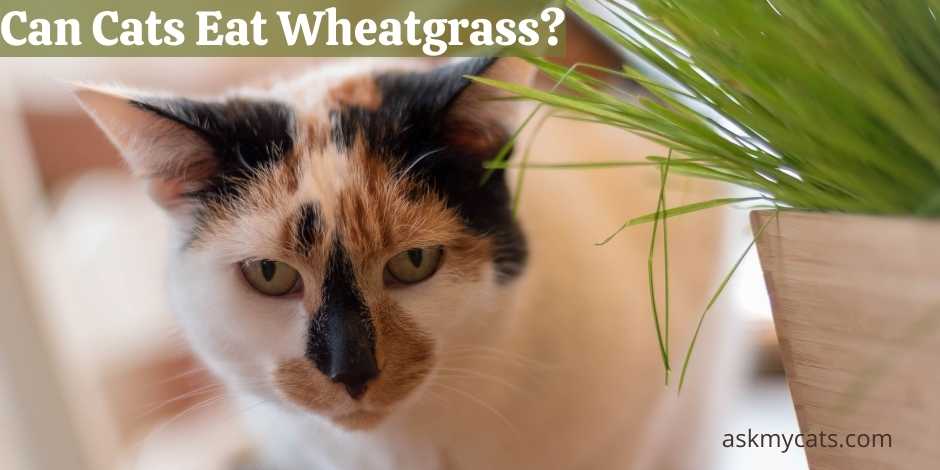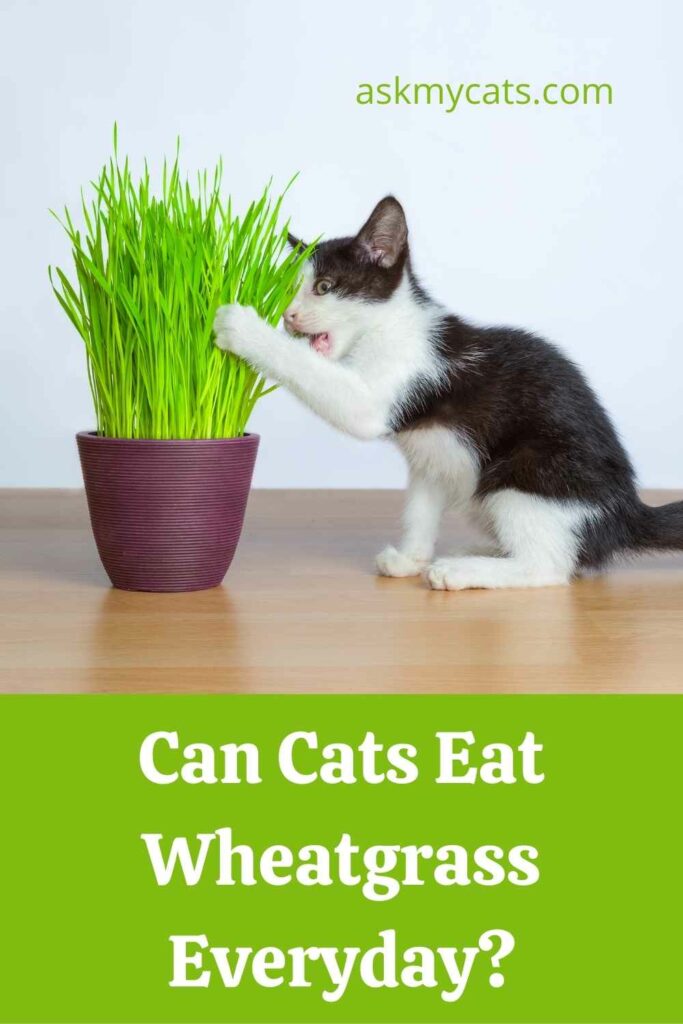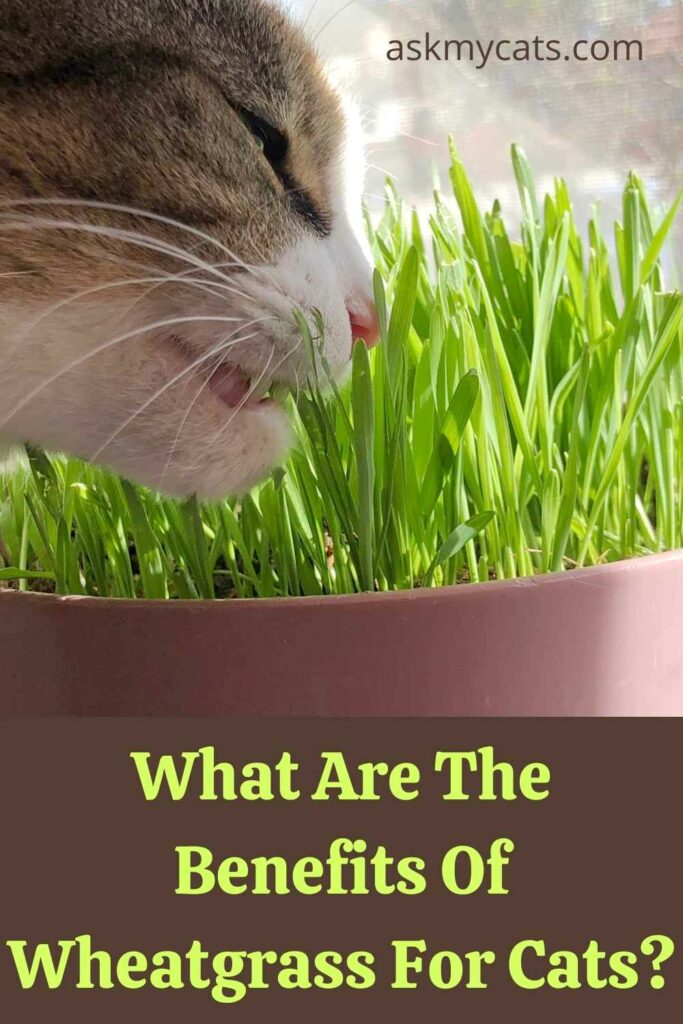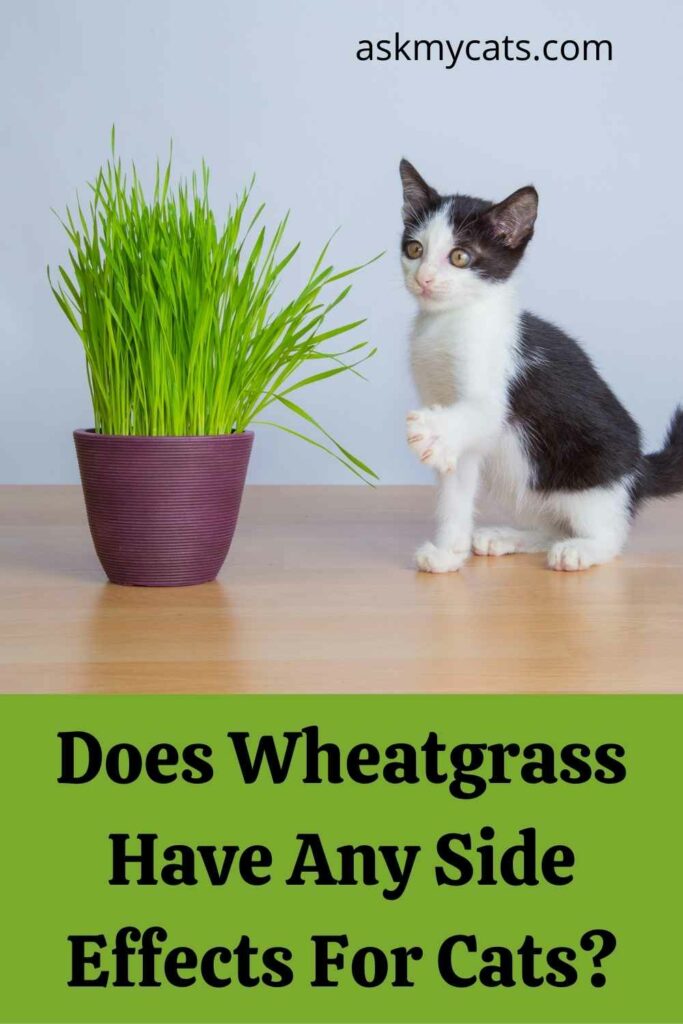Gluten cannot be digested or processed by cats in the same manner that it can by humans. Many cats are gluten intolerant, but even those that aren’t should avoid gluten. It’s only natural to associate wheatgrass with wheat gluten.
Cats may consume wheatgrass in tiny amounts and live healthily. Despite the negative consequences, cats can consume wheatgrass. It will be safe for your fluffy companion as long as it is fresh and has not been treated with chemicals.
However, be aware that it is extremely normal for your cat to vomit the wheatgrass and bring up fur balls as well.
We’ll look at what this implies for your cat and if it’s even healthy. How much should they consume? And we have addressed all of your other inquiries.


Give Your Cat the Perfect Day
Get the Free Ebook!
Can Cats Eat Wheatgrass Everyday?
Your cat should be able to eat tiny amounts of wheatgrass every day if that’s feasible.

Because the quantity of clippings they can have is difficult to estimate, you should consult with your veterinarian. You should also make sure the wheatgrass your cat consumes doesn’t contain any harmful substances.
Seeing your beloved cat eat grass may be as alarming to new cat owners as it can be to seasoned pet parents.
Felines do not survive on greenery since they are predatory animals. Regardless of their typically carnivorous diet, cats do occasionally consume grass. If you let your cat out in the yard or anyplace else outside, you may notice it nibbling on wheatgrass at some point.
It’s not unheard of, especially in longhaired breeds and cats with stomach problems. Wheatgrass use has both benefits and drawbacks. In certain situations, the drawbacks outweigh any benefits wheatgrass may provide.
Many individuals, including well-known veterinarians, swear by the health benefits of wheatgrass. Wheatgrass is a natural source of protein, fiber, vitamins, and minerals, among other nutrients. It’s also high in chlorophyll, which is necessary for hemoglobin synthesis.
It also contains a wide range of antioxidants. Doesn’t it sound magical? Wheatgrass has a lot of uses in health and wellness products, so it’s no surprise. It can’t do the same wonders for your cat as it can for you.
Wheatgrass has a lot of plant-based natural fibers, but cats can’t digest them. Nonetheless, the plant aids with digestive health. Because it causes cats to vomit, it is able to clear their digestive tract of any foreign materials, including hairballs and other objects that might create obstruction.
Throwing up is unpleasant for cats, but their instincts tell them that consuming wheatgrass will help them clear their digestive tract. That’s the most typical reason your pet could feel compelled to eat some grass stripes.
Check out more details about Can Cats Eat Wheat? Is Wheat Bad For Cats?
What Are The Benefits Of Wheatgrass For Cats?
Wheatgrass, in little amounts, boosts your cat’s physical and mental well-being.

The following are some of the reasons behind this:
Wheatgrass, as you can see, contains a variety of nutrients that are beneficial to a cat’s immunity. These minerals and vitamins can help you avoid a trip to the veterinarian.
This may seem amusing unless you have a fat and lazy cat as a pet. It might be a difficult process to get it to lose weight. Allow the cat to graze on wheatgrass while you concentrate on altering the cat’s diet.
Cats are known for being lively and energetic. If you find that the cat’s normal routine is becoming monotonous, you may add wheatgrass to its food to provide some excitement.
Wheatgrass is a lot cheaper and healthier alternative to the treats that might cause dental rot and cavities in your cat. You would be less concerned about their oral health this way.
Treating dental problems in cats will put a huge hole in your wallet, which you should avoid.
Wheatgrass contains chlorophyll, a nutrient that has been shown to improve blood flow and delay the aging process. Your cat will not only produce more powerful blood but he or she will also appear younger.
Wheatgrass also helps your cat’s night vision since it contains Vitamin A. If you see your cat eating more greens than usual, it might be a sign of a health problem such as renal illness. If this is the case, consult your veterinarian before making any substantial dietary modifications.
Also, check out alfalfa grass for cats
Does Wheatgrass Have Any Side Effects For Cats?
Increased vomiting or defecation is the most common adverse effect reported by cat owners.

This is due to your cat’s inability to digest wheatgrass; the fiber will either cause or prevent whatever is in your cat’s stomach from coming out.
If your cat seems to be vomiting a lot or his litter box habits have abruptly changed, it’s always a good idea to consult your veterinarian.
Even though eating fresh wheatgrass streaks is good for cats’ health, it also has certain drawbacks.
Wheatgrass causes stomach problems in cats of all ages and breeds. This implies that if your pet eats it, it will almost certainly puke or have diarrhea. Both alternatives are unappealing to the cat. Furthermore, they may cause secondary problems such as dehydration and lack of appetite.
Yes, depending on where your cat ate the grass stripes from, consuming wheatgrass can induce hazardous poisoning.
Herbicides and other hazardous chemicals are commonly used to preserve the streaks in outdoor wheatgrass. Poisoning in cats, dogs, and other animals is a possibility with certain substances. Unfortunately, there is no way to predict the severity of a cat’s hazardous response.
In the worst-case situation, the kitty’s body may be unable to combat the poisons. I strongly advise you to keep an eye on your pet’s grass-eating habits at all times unless you desire an emergency vet appointment.
Wheatgrass cultivated at home, whether indoors or in your own yard, is typically the safest alternative.
Some chemical particles may have sunk into the wheatgrass streaks if you’ve already treated other surrounding plants with herbicides.
Gluten is not digested and processed in the same manner as it is in humans. Gluten intolerance is common in cats, but even those who aren’t shouldn’t be fed gluten. It’s only natural to associate wheatgrass with wheat gluten.
Wheatgrass, fortunately, does not contain gluten, contrary to common perception and fundamental connections. This means that no matter how many streaks your pet gets to ingest, it will never suffer from gluten sensitivity or allergies.
Wheatgrass will also not cause your cat to acquire any dietary intolerance. In other words, as far as gluten is concerned, you have nothing to be concerned about.
Also, check out details about cat grass vs catnip
Can Kittens Eat Wheatgrass?
Wheatgrass is healthy for kittens and felines suffering from diabetes since it is low in carbohydrates.
It is also appropriate for all sorts of cats, regardless of age or breed.
Even while wheatgrass is safe for all cats, that shouldn’t be a cause to overdo it. Don’t overfeed it to your cat, and don’t use it as a substitute for the main diet.
Can Wheatgrass Make Cats Sick?
Yes, eating too much wheatgrass can lead to vomiting and pooping gastric disorders in cats.
As previously said, cats are not built in such a way that they should consume vegetables. This indicates that the amount of food consumed should be restricted. You should also be cautious if your cat suddenly starts eating wheatgrass.
They may end up eating any green plant in their proximity once they’ve become used to the grass. The other plants may be harmful to your cat, and too much wheatgrass is bad for your cat’s overall health.
It’s possible that your cat will vomit, have diarrhea, or defecate more often. Dehydration will set up rapidly, and the cat will be sick to his stomach.
Do Cats Like Wheatgrass?
Cats like to eat fresh wheatgrass because they can digest and draw nutritional benefits from plants.
Wheatgrass is offered in tiny tubs, generally near the checkout area, and is promoted as “cat grass” or “pet grass” at pet stores. This is just regular wheatgrass, which is clean, fresh, and parasite-free.
Most of the time, pet retailers will receive shipments from local farmers and marketplaces that sell them to humans and repackage them to appeal to pet owners.
It is completely safe and helpful to both cats and dogs. It’s also safer than letting your cat eat grass in your yard because it’s devoid of pesticides, parasites, and other chemicals that might damage your cat.
What Happens If A Cat Eats Wheatgrass?
If a cat eats wheatgrass, he can gain nutritional benefits from it.
Wheatgrass is high in anti-oxidants, minerals, and vitamins, all of which can be beneficial to your cat. Weight loss and control, fertility (for breeding), pain treatment, cleansing, and more are just a few of the advantages! We’ve compiled a list of nine of the top wheatgrass benefits for cats.
How Do I Give My Cat Wheatgrass?
Growing wheatgrass in a tiny pot or container inside is the simplest method to feed it to your cat.
It’s ideal to leave it on a sunny counter or on a location on the floor where the sun streams in. It may be kept growing by watering it lightly every few days. Wheatgrass may attract fruit flies, which may lay eggs in the soil, but they will not hurt you or your cat.
Online and at pet stores, you can also purchase pre-grown grass or wheatgrass kits. Wheatgrass has the advantage of being able to be given and produced indoors all year, ensuring that your cat has access to this healthy food at all times.
Wheatgrass is not appetizing to all cats, so if you want your cat to get some of the advantages of eating it, try wheatgrass juice or powder.
Also, check out Oat Grass For Cats: Is Oat Grass Good For Cats?
How Much Wheatgrass Can I Give My Cat?
Your cat will eat as much wheatgrass as it needs or wants if you provide it in its natural state.
Most cats only eat a small quantity at a time, but some will consume a substantial amount. It is completely safe for your cat to consume a lot of wheatgrass in one sitting.
When it comes to juice or powder, keep in mind that these are more concentrated forms of vitamins and minerals, and too much of either might be harmful to your cat.
Is Wheatgrass Powder Safe For Cats?
Wheatgrass powder is safe for cats as long as it contains solely wheatgrass and the amount of powder is kept to a minimum.
Because this is a concentrated version, similar to wheatgrass juice, you should only feed it to your cat in little amounts.
You may give your cat the advantages by sprinkling a small amount of the powder in their wet food, or you can mix it in water and give it to them to drink. Follow the mixing instructions on the package and feed it to your cat as you would juice.
Is Wheatgrass Juice Safe For Cats?
Wheatgrass juice, like wheatgrass in its natural state, is completely safe for cats to ingest.
Because this type is rather concentrated, you’ll want to keep the quantity your cat consumes on a daily basis to a minimum. Allow half a spoonful of juice per 5 pounds of body weight each day for your cat.
As a result, a 10-pound cat can eat an entire tablespoon. If your cat enjoys the flavor, you may mix it with water, food, or drink it straight.
Why Does My Cat Go Crazy For Wheatgrass?
Wheatgrass is also enjoyed by many cats as a source of nutrition, fiber, and intellectually and physically engaging exercise.
Also, check out Can Cats Eat Barley
Frequently Asked Questions
How To Care For Wheatgrass For Cats?
If your cat does not begin to graze the wheatgrass on her own, try putting clippings in her diet or combining them with water. She will understand that this leafy green is a pleasant treat once she has eaten it, and she will be encouraged to graze on it.
Can Cats Eat Other Grass?
Cats will eat nearly any other type of grass, even lawn grass. Wheatgrass, on the other hand, is quite popular among them, and it is safer and more nutritious than the others.
What is the Difference between Wheatgrass and Cat Grass?
Wheatgrass is a kind of cat grass. Other plants that produce cat grass include barley, bluegrass, oats, flax, fescue, and rye. The ultimate result of using various grass kinds to produce cat goods is what we call cat grass.
Final Words
Wheatgrass is harmless for cats and may be used as a substitute for other treats. It can also be consumed in addition to the regular diet.
When cats consume wheatgrass, a variety of elements come into play, but the majority of them are beneficial to your cat. Wheatgrass can have a big impact on your cat for a variety of reasons.
You’ll also save money because you won’t have to see your veterinarian as frequently. Please leave your questions about your pet friend’s feeding habits in the comments section below. We’ll get back to you as soon as possible.
You might also like to know the difference between cat grass vs wheatgrass

My cat has problems with her skin one minute shes ok then goes mad stretching her skin making it sore and she goes bold can I give her wheat grass will it help her skin from debbie
Hello debbie,
Yes wheatgrass can be beneficial for skin of your cat.
But I would highly suggest you to first consult your vet once for such skin issues.
Happy cat parenting.